Preparation and hypoglycemic effects of chromium- and zinc-rich Acetobacter aceti
2022-06-21YongYiHuangXiangKunQinYuanYuanDaiLiangHuangGanRongHuangYanChunQinXianWeiYanQiangHuang
lNTRODUCTlON
Diabetes mellitus is a disease of chronic glucose metabolism disorders[1,2]. In 2020, the world’s population with diabetes was about 495 million, and this is expected to increase to 700 million by 2045[3,4]. The pain and burden of diabetes and its complications are major health and socio-economic concerns for people all over the world. Diabetic patients are often challenged by serious complications, such as diabetic nephropathy, diabetic retinopathy, cardiovascular system disease,
, which pose a serious threat to human life and health[5-7]. Patients with type 2 diabetes mellitus (T2DM) account for 90% to 95% of all diabetic patients, making T2DM an important focus of much research into the epidemiology of diabetes. Scholars have heavily researched the causes of diabetes and methods for its prevention, for many years; however, there remains no effective cure, due to the disease’s unclear causes and complicated pathogenesis. Moveover, its underlying mechanism has yet to be fully elucidated[8,9]. The current comprehensive prevention and treatment measures for diabetes mainly include diet control, exercise, and drug therapy[10-12].
Afterwards the teacher decided to do a class project to see what kind of impact recognition would have on a community. She gave each of the students three I more ribbons and instructed them to go out and spread this acknowledgment ceremony. Then they were to follow up on the results, see who honored whom and report back to the class in about a week.
The drugs used for the treatment of diabetes are mainly chemical agents, with few biological drugs available. Health drinks, including kombucha (which contains yeast, lactic acid bacteria, and acetic acid bacteria and their metabolites) and black tea, can lower blood sugar, blood pressure, blood lipids,
, and exert certain auxiliary effects on patients with hypertension, hyperlipidemia, and hyperglycemia; the main active ingredients in these drinks that lowers blood sugar are D-glucaric acid-1, 4-lactone and tea polyphenols, respectively[13]. However, the effect of bacterial metabolites from these drinks on reducing blood sugar is not fully elucidated. For example,
(
) contains dihydronicotinamide-adenine dinucleotide and glucuronic acid dehydrogenase, among other metabolites, which decompose glucose through glycolysis; however, kombucha fails to improve the effect of reducing blood sugar by fully utilizing the effects of these metabolic enzymes. Therefore,
can only be used as a healthy drink for adjuvant therapy. In order to capitalize on the ability of these bacteria to metabolize glucose, increase the contents of dihydronicotinamide-adenine dinucleotide glucuronic acid dehydrogenase, and other metabolic enzymes, and exert their hypoglycemic effects, their full effectiveness must be realized
before these bacteria can be used as a hypoglycemic drug.
To improve the effect of
on lowering blood sugar, the present study provides a method for preparing and applying chromium- and zinc-rich
This method demonstrated a significant increase in the amount of dihydronicotinamide-adenine dinucleotide, glucuronic acid dehydrogenase, chromium, and zinc inside the cells and other microelements in the specimens we prepared. These enriched bacteria had a notable repair effect on pancreatic islet cells, promoted insulin secretion, and demonstrated a good hypoglycemic effect. Therefore, chromium- and zinc-rich
can be used as a candidate drug for the treatment of T2DM.
MATERlALS AND METHODS
Materials
Glucose (Guangdong Guanghua Technology Co., Ltd, batch number:20200403); yeast extract (Beijing Aoboxing Bio-tech Co., Ltd, batch number:20200422); calcium carbonate (Shanghai Titan Scientific Co., Ltd, batch number:P1260108); agar (Beijing Solarbio Technology Co., Ltd, batch number:310C022); anhydrous alcohol (Shanghai MacLean Biochemical Technology Co., Ltd, batch number:C11974944); chromium chloride (Shanghai MacLean Biochemical Technology Co., Ltd, batch number:C10717130); zinc chloride (Shanghai MacLean Biochemical Technology Co., Ltd, batch number:C10730413); 50-mL centrifuge tubes and EP tubes (Jiangsu Lexinkang Medical Equipment Co., Ltd); streptozotocin (STZ) (Shanghai McLean Biochemical Technology Co., Ltd, batch number:C20PA038100B); citric acid (Shanghai McLean Biochemical Technology Co., Ltd, batch number:C10723907); sodium citrate (Shanghai McLean Biochemical Technology Co., Ltd, batch number:C10712912); universal pH indicator paper (Hangzhou Test Three Technology Co., Ltd); metformin hydrochloride tablets (Beijing Jingfeng Pharmaceutical Group Co., Ltd, batch number 2004032); glucose test strips (ACCU-CHEK; Roche Diabetes Care GmbH, batch number:26020933,
); specific pathogen-free (SPF) C57BL/6 mice, aged 6-8 wk (Changsha Tianqin Biological Co., Ltd);
, number:GIM1.67 (Guangdong Microorganism Conservation Centre); and MIN6 cells (China Centre for Type Culture Collection) were used. The Animal Experiment Ethics Approval Number was 20200620.
Preparation of chromium- and zinc-rich A. aceti
To prepare the STZ required to inject the mice to cause diabetes, 24 mL of 0.1 mol/L sodium citrate buffer was treated with 120 mg of STZ away from the light (equivalent to a concentration of 5 mg/mL) and placed in an ice environment. The mice were made to fast for 10 h and then treated with STZ at a dose of 0.15 mL/10 g of mouse weight (equivalent to 75 mg/kg). STZ was administered by intraperitoneal injection for 3 consecutive days. Before each intraperitoneal injection, the STZ liquid was carefully pipetted with a 1 mL syringe to mix the precipitate before it was extracted to maintain the STZ concentration. After each intraperitoneal injection, mice were deprived of food and water for 90 min. On the 7
d after the last administration (the mice were made to fast for 10 h before blood collection), blood was collected from their caudal veins, and the fasting blood glucose (FBG) levels of the mice were measured with a Roche glucometer. Pathological models of mice with diabetes were confirmed as having been successfully established when FBG ≥ 16.7 mmol/L.
Detection of coenzymes and metals in A. aceti
Collection of :
Cell suspensions (100 mL) of
were removed and distributed across a sterile 96-microwell plate, with the culture solution used as a blank control. The absorption of the suspension and the
culture solution were measured at 600 nm using the microplate reader and calculated as OD1 and OD2, respectively, with the final OD value of the
suspension taken as the difference OD1-OD2. The
suspension was centrifuged at 8000 rpm for 10 min to remove the supernatant; the precipitate (the
) was then washed once with 1 mL sterile PBS and centrifuged at 13000 rpm for 1 min to remove the supernatant. Thereafter, the precipitate was weighed and resuspended with sterile water for a final concentration of
at 0.1 mg/mL.
Detection of chromium and zinc in :
Collected samples were sent to Shanghai WEIPU Chemical Technology Service Co., Ltd, and the contents of chromium and zinc were detected by inductively coupled plasma mass spectrometry.
Detection of NAD+/NADH in:
The concentrations of NAD+/NADH in the
was determined using the NAD+/NADH assay kit with WST-8 (Beyotime Biotechnology).
Detection of glucose dehydrogenase in :
Solarbio’s “glucose dehydrogenase microplate assay kit” was used to detect glucose dehydrogenase concentrations in
, according to the instruction manual.
For the preparation of citrate buffer, 2.10 g of citric acid was treated with 100 mL of double distilled water to make a citric acid mother liquor (solution A), after which 2.94 g of trisodium citrate was treated with 100 mL of double-distilled water to make a sodium citrate mother liquor (solution B). Solution A and solution B were mixed in a ratio of 1:1.32 (or 1:1), and the pH value was measured with a pH meter and adjusted from 4.2 to 4.5. This represented the 0.1 mol/L sodium citrate-hydrochloric acid buffer solution required to prepare streptozotocin (STZ).
was collected (OD = 10), sonicated, and stored at -20 °C for later use. MIN6 cells, a pancreatic islet cell line, were revived, the cell concentration adjusted to 1 × 10
CFU/mL, and then cultured in 5 mmol/L and 25 mmol/L high-glucose 1640 medium on a 96-well plate with 90 mL/well. After 12 h, the cells were diluted 10-fold and dosed with 10 mL of collected
(with or without metal enrichment; OD = 10), the dose of which was equivalent to 1 × 10
CFU/mL of bacteria. A positive drug control group (diformin tablets) and negative drug control group (PBS) were included. Approximately 24 h after dosing, cell growth was detected with the CCK-8 kit (Beyotime Biotechnology).
were revived and cultured in a liquid enriched medium, with the concentration of the bacterial solution OD
= 0.9 to 1.5, which is about 3 × 10
to 5 × 10
CFU/mL. To enrich the bacteria with chromium and zinc,
were cultured in a liquid medium (the concentrations of chromium trichloride and zinc chloride were both 64 mg/mL) with the initial concentration of the bacterial solution set to 1 × 10
CFU/mL and shaken for 48 h at 250 rpm; this cultivation was repeated once. Following the enrichment cultivations, the bacterial solution was collected, centrifuged to remove the supernatant, and washed by phosphate buffer saline (PBS); the precipitate was the chromium- and zincrich
.
The diabetic mice were designated from high to low, according to their blood glucose levels, and the model mice were divided into a model group (PBS), positive control group (metformin), metal chromium plus zinc group (concentrations of chromium and zinc calculated as 1 × 10
mg/mL and 2 × 10
mg/mL, respectively, according to the highest content of chromium- and zinc-rich
),
group (OD = 1), and chromium- and zinc-rich
group (OD = 1). There were six mice in each group, and each was given 0.5 mL of treatment by gavage.
Evaluation of hypoglycemic activity :
After the diabetic models were successfully established, the mice were given intragastric administration of treatment on the second day, once a day, for 15 consecutive days. The normal control group and the model group were given the same amount of PBSwater. The positive drug control group was given diformin tablets (ground into powder, prepared into a suspension with reverse osmosis water, and administered intragastrically at 0.320 g/kg/d). The metal chromium plus zinc group was given chromium trichloride (1 × 10
mg/mL) and zinc chloride (2 × 10
mg/mL) intragastrically. Through general observation, the activity and spirit of the mice, their eating and drinking, urine and feces, and the dryness and wetness of the bedding were observed every day during the 15 d of administration. Starting at the beginning of treatment, fasting blood glucose was measured every 3 d. After 15 d of administration, the mice were fasted for 10 h and blood was collected from the eyeballs. Thereafter, the mice were sacrificed, with the tissue taken from their pancreas islets, fixed with formaldehyde, and processed for hematoxylin and eosin (HE) staining and immunohistochemistry with the apoptosis-related Bax proteins. Tissue from pancreatic islets was also prepared for electron microscopy to analyze the ultrastructural damage and possible repair on tissues and cells of pancreatic islets. The weights of mice were recorded every 3 d.
Seventy SPF grade C57BL/6J female mice, aged 6 wk and weighing 20 ± 2 g, were allowed to eat and drink without restrictions during 5 d of adjustable feeding. Six mice were randomly selected as the normal control group, and the rest were used for model construction.
were collected (OD = 10), sonicated, and stored at -20 °C for later use. MIN6 pancreatic islet cells were revived, the cell concentration adjusted to 1 × 10
CFU/mL, and cultured in 5 mmol/L and 25 mmol/L high-glucose 1640 medium on a 6-well plate with 1.98 mL/well. After 12 h, the cells were dosed with 20 mL
(with or without metal enrichment; OD = 10), the dose of which was equivalent to 1 × 10
CFU/mL of bacteria. A positive drug control group (diformin tablets) and negative drug control group (PBS) were included. Some 24 h after dosing, the cell supernatant was collected, with the insulin content detected by a commercially-available enzyme-immunized mouse insulin ELISA kit.
Detection of glucose processing by A. aceti
Chromium- and zinc-rich
and control
were collected, with the initial concentration adjusted to 1 × 10
CFU/mL. The glucose concentration of the liquid medium was detected with a blood glucometer in
cultured at 30 °C for 12 h, 24 h, 36 h, and 48 h.
Safety evaluation of chromium- and zinc-rich A. aceti
Chromium- and zinc-rich
were collected and adjusted to 10 times the therapeutic dose (OD = 10). Aliquots of 1-mL were administered, respectively, to the mice three times a day for 7 consecutive days, with the body weights and the pathological changes of the organs detected.
Everything went well for a week or a fortnight, and then the woman said, Hark you, husband, this cottage is far too small for us, and the garden and yard are little; the Flounder might just as well have given us a larger house. I should like to live in a great stone castle; go to the Flounder, and tell him to give us a castle. Ah, wife, said the man, the cottage is quite good enough; why should we live in a castle? What! said the woman; just go there, the Flounder can always do that. No, wife, said the man, the Flounder has just given us the cottage, I do not like to go back so soon, it might make him angry. Go, said the woman, he can do it quite easily, and will be glad to do it; just you go to him.
RESULTS
Determination of coenzymes and metals in chromium- and zinc-rich A. aceti
The concentration of chromium metal in the
prepared as described in the methods section above was 28.58-34.34 mg/kg, and the zinc metal concentration was 5.35-7.52 mg/kg, both of which were significantly higher than those in the untreated
(chromium:1.05-2.29 mg/kg; zinc:0.18-0.26 mg/kg) (Figure 1A). The concentration of NADH was 5.13 to 7.26 mM, which was significantly higher than that in the non-cultured
(0.86 to 1.02 mM) (Figure 1B). The concentration of glucose dehydrogenase was 446.812-567.138 U/g, which was significantly higher than that of non-cultivated
(54.126-93.651 U/g) (Figure 1C).
A beautiful house was got ready for her, and Prince Ring had the two oaks planted in the garden just in front of her windows so that she might have the pleasure of seeing them constantly
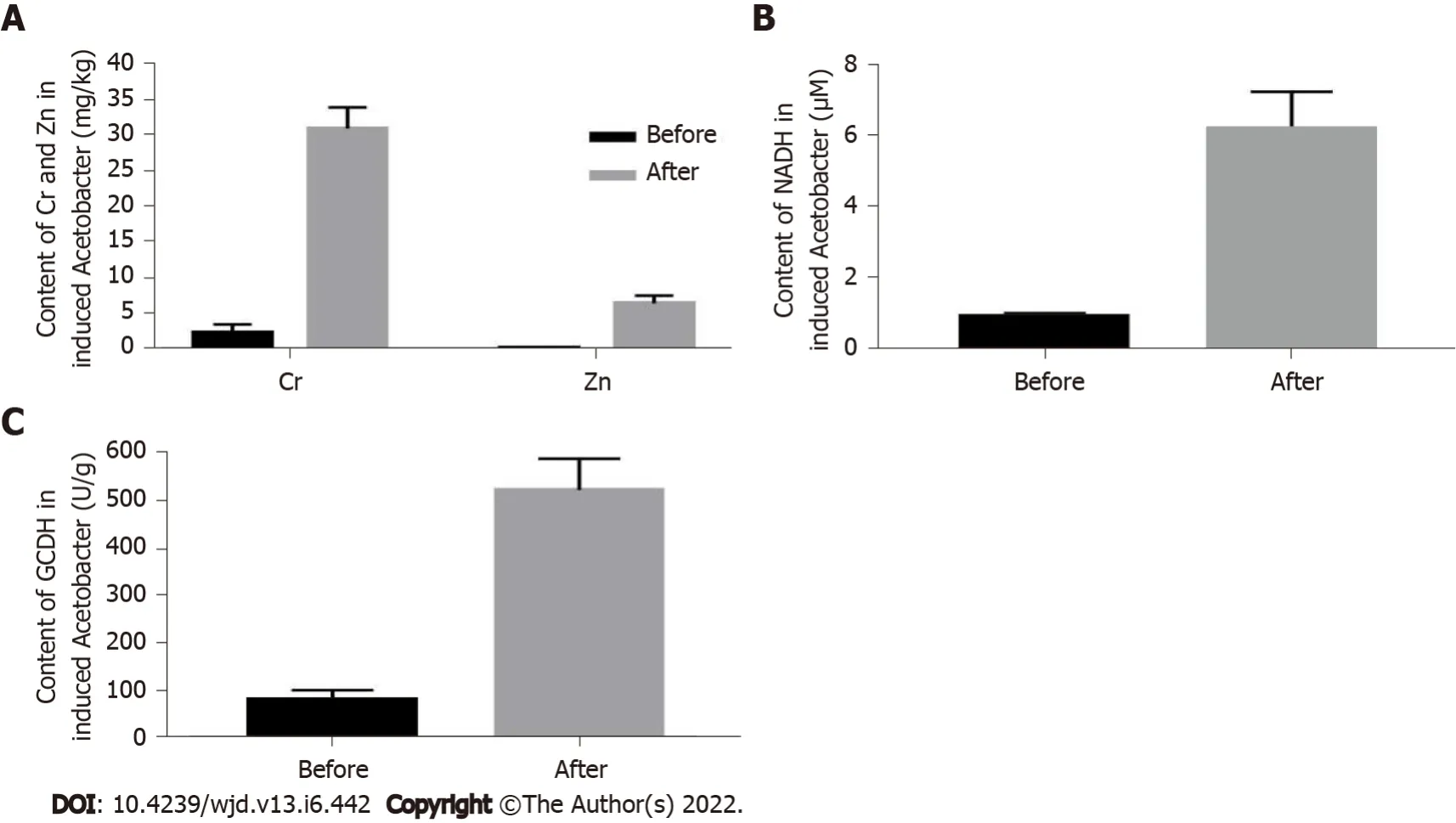
Evaluation of the therapeutic effects of chromium- and zinc-rich A. aceti on mice with diabetes
After 7 d of treatment, the diabetic mice (mice with FBG ≥ 16.7 mmol/L) treated with chromium- and zinc-rich
were found to be in a good mental state, with bright eyes and normal activity, normal intake of food and water, urinate, and normal defecation, with their beddings dry. The fasting blood glucose was detected every 3 d after the initial administration of treatment, and the diabetic mice treated with chromium- and zinc-rich
(OD = 1) had significantly lower blood glucose than mice in both the positive drug control group (diformin tablets) and the metal chromium plus zinc group (Figure 2).
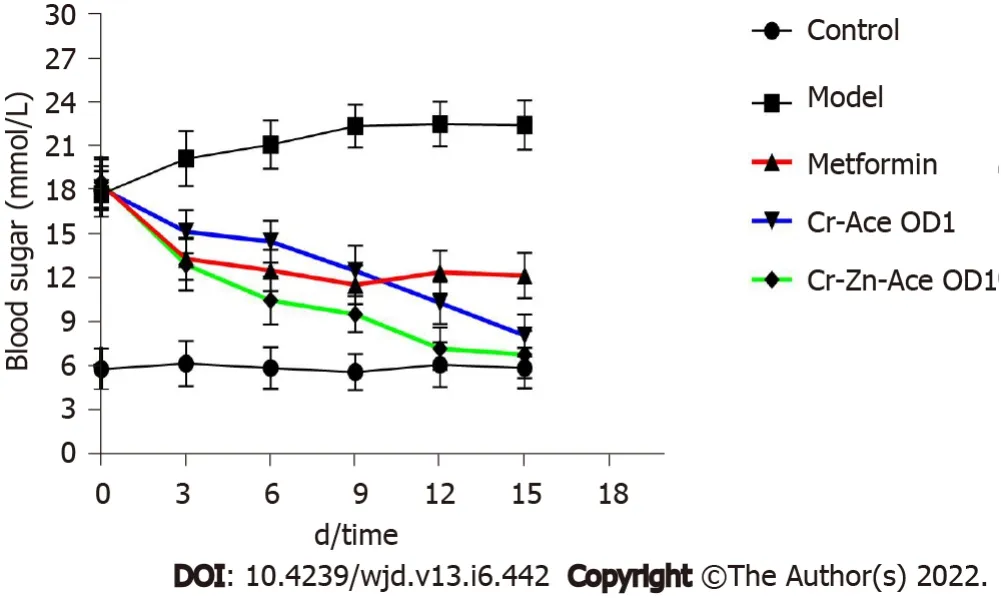
After 15 d of treatment, HE staining of the pancreas tissue indicated fewer cells undergoing apoptosis, less structural atrophy, and hardly any vacuoles detected in the chromium- and zinc-rich
group (OD = 1) (Figure 3). Immunohistochemistry analysis of apoptosis-related Bax proteins confirmed that the apoptosis of islet cells was significantly reduced (Figure 3). Electron microscopy of pancreas islet tissue confirmed that the ultrastructural damage was alleviated after treatment with the chromium- and zinc-rich
with a small expansion range of endoplasmic reticulum, slightly swollen mitochondria, and the amount of autophagic vacuolization significantly reduced (Figure 3).
To prepare a new type of chromium- and zinc-rich A. aceti and explore its hypoglycemic effects on enhancing the application of probiotics in the treatment of diabetes.
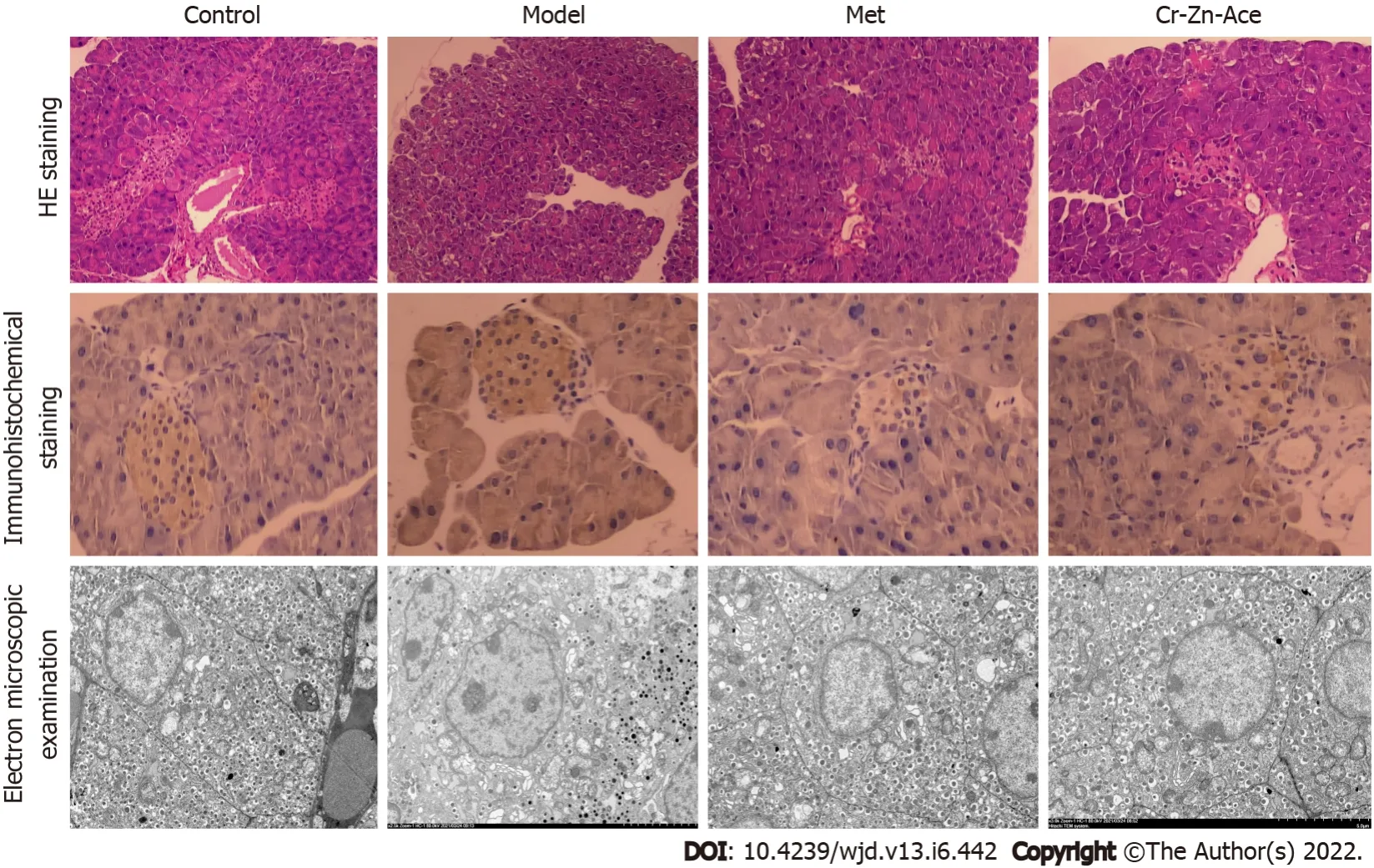
The body weights of the mice after treatment with chromium- and zinc-rich
were recorded every 3 d. The weights of diabetic mice in the chromium- and zinc-rich
(OD = 1) were found to recover well, with no significant difference from those of the positive drug control group (metformin), as displayed in Figure 4.
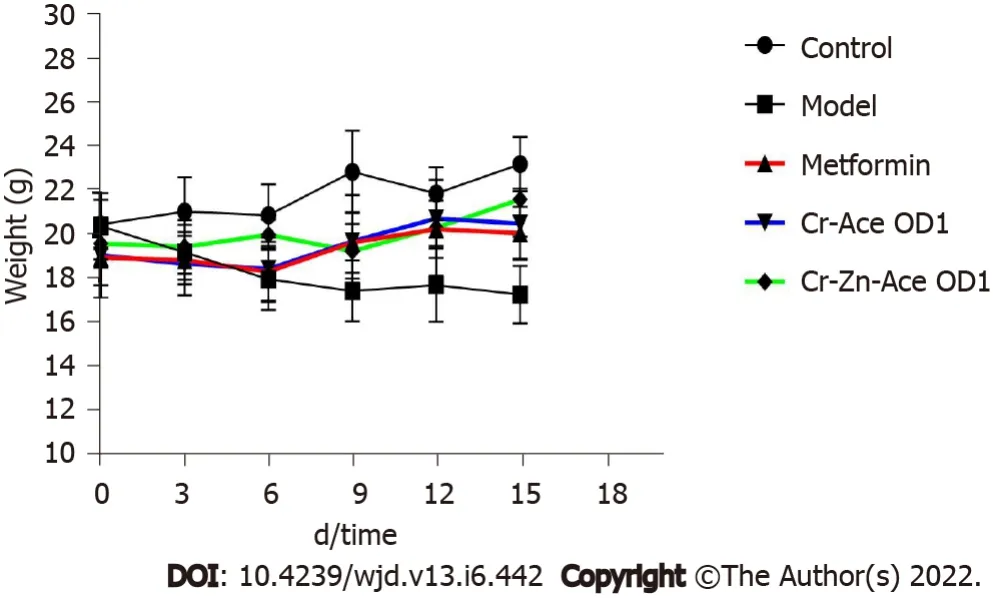
Evaluation of chromium- and zinc-rich A. aceti on pancreatic islet cells MIN6
Chromium- and zinc-rich
promoted the growth of MIN6 cells significantly better than both the positive and negative control groups in the high glucose 1640 medium, as indicated by cytotoxicity measured with the CCK-8 kit (Figure 5). This result implied that chromium- and zinc-rich
could promote the growth of MIN6 pancreatic islet cells.
Tina shook her head. The other gargoyles are much crankier than us. The reason I m nicer to you is I like it here. I never want to leave. I like you too.
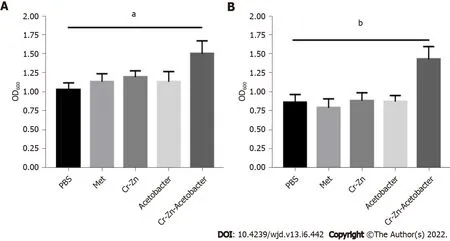
The insulin content of the supernatant in MIN6 cells incubated in the 25 mmol/L high-glucose 1640 medium treated with chromium- and zinc-rich
(OD = 10) group was significantly higher than that in the positive and negative control groups (Figure 6). This result implies that chromium- and zincrich
could promote insulin secretion of MIN6 islet cells.
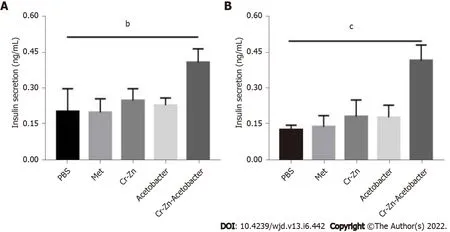
Detection of the capacity of chromium- and zinc-rich A. aceti for processing glucose
The glucose content in medium containing chromium- and zinc-rich
and control
both decreased significantly as incubation times increased; however, this decrease was significantly more pronounced for the chromium- and zinc-rich
compared to the
group (Figure 7). This result implies that chromium- and zinc-rich
are better at decomposing glucose than the untreated bacteria.
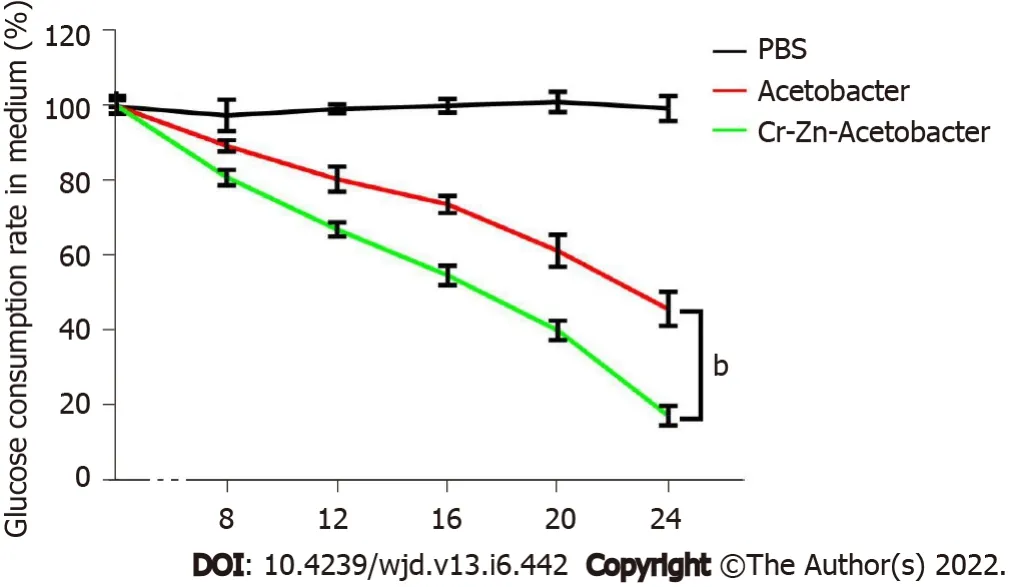
Safety evaluation of chromium- and zinc-rich A. aceti
Ten times the dose of chromium- and zinc-rich
was administered to mice by gavage with no change detected in the weights and no pathological damage found in the liver, spleen, kidneys, and stomach (Figure 8). This result implies that
is biosafe.
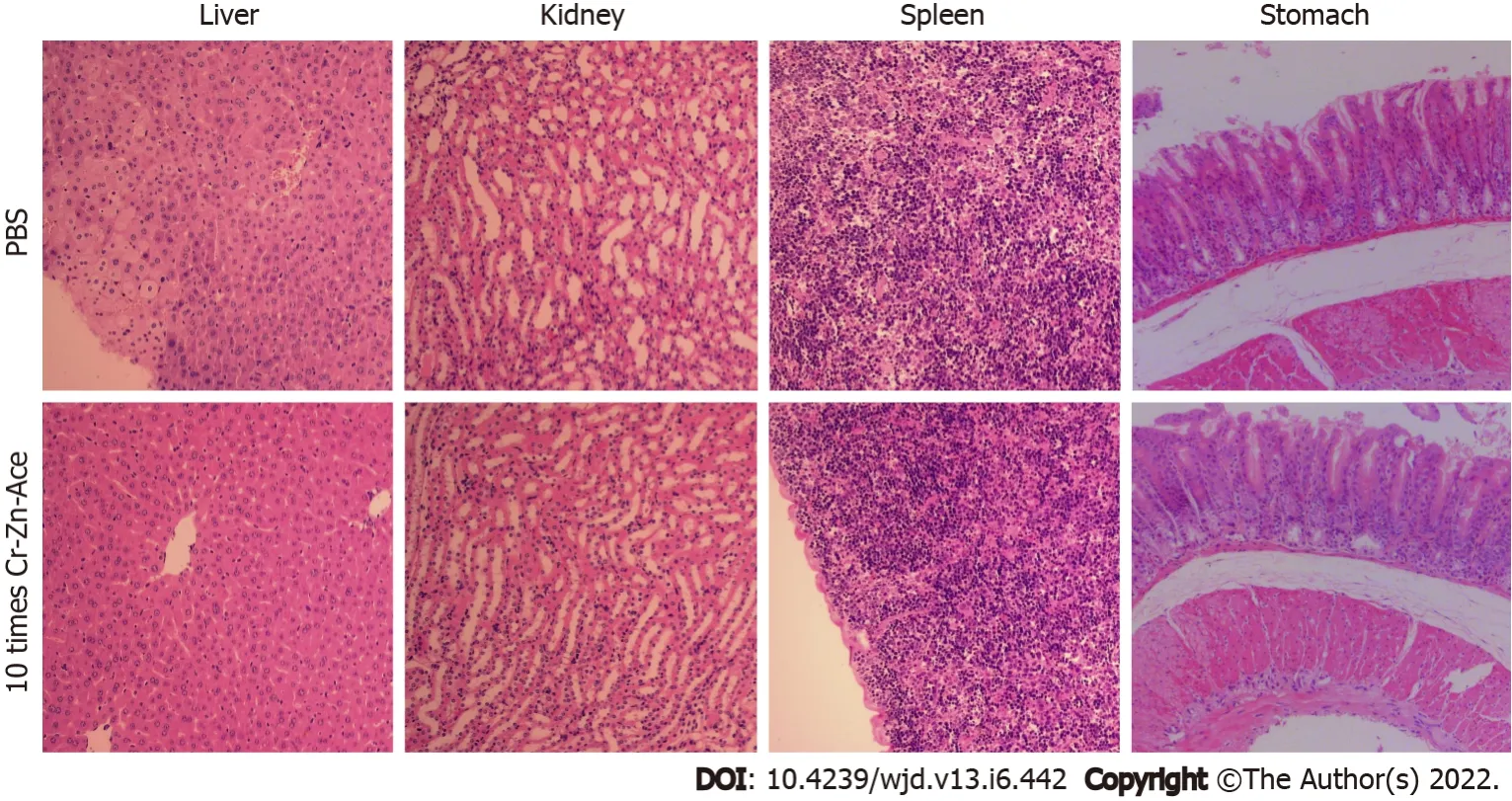
DlSCUSSlON
At present, the incidence of diabetes is high, with no known cure. The conventional therapy is long-term use of hypoglycemic drugs and symptomatic treatment. However, in the long-term treatment process, drugs are prone to resistance among non-compliant patients who fail to adhere to treatment regimens. Therefore, in addition to helping patients control blood sugar long-term, it is vital that we clearly identify the risk factors for diabetes to prevent patients from developing this disease. An important area that may be significant in both the long-term treatment and prevention of diabetes is the use of supplemental micronutrients, as diabetic patients are often deficient in B vitamins and micronutrients, such as chromium, zinc, and selenium[14-16].
Chromium was designated as an essential microelement for the human body in 1989. The body absorbs Cr
mainly from food, including meat, whole grain, millet, pepper,
. The daily intake for adults recommended by the United States Food and Drug Administration’s Center for Food Safety and Applied Nutrition Food Safety Recommendations Committee is 25-35 μg (as of 2001). Studies have found that plasma chromium levels are negatively correlated with the risk of type 2 diabetes and prediabetes. Chromium deficiency may lead to impaired glucose tolerance, insulin resistance, and elevated blood sugar. Chromium levels in the human body will decrease with age, with chromium deficiency becoming severe in old people[17-19]. According to evidence-based medicine meta-analysis studies, chromium increased insulin sensitivity mainly by activating insulin receptor kinase activity, inhibiting phosphatase activity, and increasing phosphorylation of insulin receptors[20,21]. Low molecular weight chromium binding substance was found to be combined with insulin receptors and activate tyrosine kinase activity on insulin P receptors, thus enhancing insulin signal transduction. However, at an insulin concentration of 100 nmol/L, the tyrosine kinase activity in insulin receptors was significantly enhanced if insulin was dosed with chromium[22,23]. In addition, it was found that chromium could also promote the translocation of GLUT4 to the cell membrane by activating protein kinase B and adenosine monophosphate to activate protein kinase signaling pathways and by activating the activity of p38 mitogen-activated protein kinase[24,25]. Despite much related research, the specific mechanism of lowering blood sugar through chromium supplementation remains unclear.
Zinc ions are an important part of the insulin molecule, maintaining the stability and biological effects of insulin[26-28]. Zinc plays a key role in the synthesis, storage, and secretion of insulin in pancreatic β cells and can increase the activity of the insulin signaling pathway. However, zinc deficiency can lead to a decrease in insulin secretion[29,30]. In addition, the formation of hexamers that contain zinc is required in the synthesis of insulin; therefore, zinc deficiency will lead to restricted insulin synthesis and reduced insulin sensitivity, thus increasing the risk of diabetes[31,32]. Studies have found that zinc lowers blood sugar mainly through antioxidant responses, inhibition of inflammatory factors, and antiapoptosis effects[30,33]. Intracellular zinc has also been found to be regulated by zinc transporters, with the uptake, storage, and distribution regulated by metallothioneins[34,35]. Studies have found that zinc can inhibit the inflammatory response and has an anti-apoptosis effect at a concentration higher than 100 μmol/L[36]. Therefore, increasing the intake of zinc can increase the level of metallothionein, which helps mediate anti-apoptosis,
[31,37]. Some scholars have suggested that the effects of a high-zinc intake on lowering blood sugar may be associated with its ability to reduce variation in zinc transporters[38]. Therefore, given the important role of zinc in glycemic control, a deficiency of zinc can lead to glucose metabolism disorders, while high intake may reduce the risk of glucose metabolism disorders and diabetes.
Above all, chromium and zinc supplementation can stabilize blood sugar in an indisputable manner. The key is how to supplement chromium and zinc through a proper, safe, and scientific approach. In the present study, chromium trichloride, zinc chloride, and
were co-cultured to induce the production of chromium- and zinc-rich
following simple protocols with high yield. Chromium- and zinc-rich
prepared using this method not only helped
exert the effect of decomposing glucose but also enhanced the hypoglycemic effect seen in untreated
. Because the chromium and zinc was transformed by the bacteria, biological safety was ensured, which means that it is possible that this can be used as a new hypoglycemic biological drug. The hypoglycemic mechanism of chromium- and zinc-rich
was preliminarily explored, with findings of these bacteria predominantly leading to increased dihydronicotinamide-adenine dinucleotide and glucuronide dehydrogenase levels in
enhancing the ability to degrade glucose. In addition, its hypoglycemic mechanism was found to be not much different from those of chromium and zinc, which are metal microelements. However, because the source of nutrition for the growth of
is ethanol, these bacteria do not survive for long in the body, and, therefore, they cannot exert long-term hypoglycemic effects, which will be further addressed in future research.
CONCLUSlON
Chromium trichloride and zinc chloride can be employed to induce the preparation of chromium- and zinc-rich
, which has a significantly enhanced hypoglycemic effect relative to normal
and can biotransform chromium and zinc in a way that improves the safety of administering these metals as a treatment for diabetes.
ARTlCLE HlGHLlGHTS
Research background
They laid her upon the humble bed; there was not a yard of linenon it, only a woollen coverlet to keep the occupant warm.Life returned to her, but she was delirious, and knew nothing ofwhat had happened or where she was; and it was better so, foreverything she loved and valued lay buried in the sea. The samething happened to her ship as to the one spoken of in the song about The King of England s Son. Alas! how terrible to seeThe gallant bark sink rapidly. Fragments of the wreck and pieces of wood were washed ashore; they were all that remained of the vessel. The wind still blew violently on the coast.
Research motivation
This research provides a theoretical basis for the application of new chromium- and zinc-rich Acetobacter aceti (A. aceti) to treat diabetes.
Research objectives
When you have captured a whole lot of people in this way, lead your train straight on with you; you will come to a big town where a Princess lives who has never been known to laugh
Suddenly Ivan s face brightened, and, looking at his wife, he said, Wife, why shouldn t we make a snow woman too? Why not? replied Marie, who happened to be in a very good temper; it might amuse us a little
Research methods
A. aceti was cultured in a liquid medium that contained chromium trichloride and zinc chloride.
Research results
A new type of chromium and zinc rich A. aceti was successfully prepared.
Thank you, sir. And God bless you, the grateful child said to him. The man then watched the little boy push his brother to the sidewalk toward their home.
Research conclusions
Chromium- and zinc-rich A. aceti has a significantly enhanced hypoglycemic effect and can biotransform chromium and zinc to improve safety for administering these metals as a treatment.
Our love started when he told his sister he liked me. I was shocked to hear that because I thought he only saw me as a friend. I knew I felt something for him but didn’t think he also felt something too. We soon got together the funny thing is that his sister was also with his best friend. So we would always go out all four. I enjoyed spending time with my best friend but also my boyfriend I felt like I had really found the guy I wanted.
As I looked toward the bright hallway lights from the darkened room, I thought for a moment that I was dreaming. “No thanks,” I responded. “I just came on duty. I’ll grab something at lunch.”
At present, there are no ideal drugs to treat diabetes. Acetobacter and other probiotics can play a role in the treatment of diabetes; however, their effect is not significant. In this study, metal compounds were used to enrich Acetobacter with chromium and zinc in an effort to enhance the hypoglycemic effect of these bacteria.
Research perspectives
The new method described has very good application prospects.
Huang YY was responsible for the experimental research; Qin XK, Dai YY, Huang L, and Huang GR consulted the literature and wrote the first draft, then corrected and improved the manuscript; Wei X and Huang YQ designed, checked, modified, and finalized the manuscript, contributed equally to this work, and agreed to serve as co-corresponding authors; All authors proofread the revised manuscript.
the Fourth Self-funded Projects of Baise Scientific Research and Technology Development Plan, No. 20203402; and School-level Scientific Research Project of Youjiang Medical University for Nationalities, No. yy2021sk029.
All procedures involving animals were reviewed and approved by the Institutional Animal Care and Use Committee of the Youjiang Medical University for Nationalities.
Then she was sent into the kitchen, where she carried wood and water, poked7 the fire, washed vegetables, plucked fowls8, swept up the ashes, and did all the dirty work
The authors declare that they have no conflicts of interest.
But only after the girl was enticed9 into(,) matrimony(,) did I begin to feel my self-inflicted anguish10. This over-reaction of mine not only failed to put an end to my permanent handicapped , but also gave me lifetime regret. I was deprived of the earthly pleasure of walking with my wife in the street with my strong arm around her delicate neck because it meant that my feet would be llifted from the land that had nurtured11(,) me, and worse still, my scared belly-button would be put on public display.
All experimental data are presented in the paper.
The authors have read the ARRIVE Guidelines, and the manuscript was prepared and revised according to the ARRIVE Guidelines.
This article is an open-access article that was selected by an in-house editor and fully peer-reviewed by external reviewers. It is distributed in accordance with the Creative Commons Attribution NonCommercial (CC BYNC 4.0) license, which permits others to distribute, remix, adapt, build upon this work non-commercially, and license their derivative works on different terms, provided the original work is properly cited and the use is noncommercial. See:https://creativecommons.org/Licenses/by-nc/4.0/
China
If one heart could touch another, this gentle, sad man had truly touched mine. He was right, the age didn t matter; neither did all the parades, fireworks, hot dogs or celebrations. All of the Fourths of July that had ever been or ever would be didn t matter to him or to his son. All that mattered was this man s need to give someone he d loved and lost a shared moment of declaration.
Yong-Yi Huang 0000-0001-5889-2089; Xiang-Kun Qin 0000-0003-0314-8978; Yuan-Yuan Dai 0000-0002-5522-4154; Liang Huang 0000-0001-7937-8150; Gan-Rong Huang 0000-0001-5580-8689; Yan-Chun Qin 0000-0003-4769-1083; Xian Wei 0000-0003-0421-114X; Yan-Qiang Huang 0000-0002-0867-0178.
Zhang H
A
Zhang H
1 Kaneko K, Yatsuya H, Li Y, Uemura M, Chiang C, Hirakawa Y, Ota A, Tamakoshi K, Aoyama A. Risk and population attributable fraction of metabolic syndrome and impaired fasting glucose for the incidence of type 2 diabetes mellitus among middle-aged Japanese individuals:Aichi Worker's Cohort Study.
2020; 11:1163-1169 [PMID:32022993 DOI:10.1111/jdi.13230]
2 Richter B, Hemmingsen B, Metzendorf MI, Takwoingi Y. Development of type 2 diabetes mellitus in people with intermediate hyperglycaemia.
2018; 10:CD012661 [PMID:30371961 DOI:10.1002/14651858.CD012661.pub2]
3 National Centre for Statistics & Information of Oman Population Projections 2020-2040, 2017. [cited 1 January 2020].Available from:https://ncsi.gov.om/Elibrary/LibraryContentDoc/ben_projection-Eng_87f44b27-0bf3-4a80-b2d2-1ead231a0165.pdf
4 Awad SF, Al-Mawali A, Al-Lawati JA, Morsi M, Critchley JA, Abu-Raddad LJ. Forecasting the type 2 diabetes mellitus epidemic and the role of key risk factors in Oman up to 2050:Mathematical modeling analyses.
2021;12:1162-1174 [PMID:33112504 DOI:10.1111/jdi.13452]
5 Ryder JR, Northrop E, Rudser KD, Kelly AS, Gao Z, Khoury PR, Kimball TR, Dolan LM, Urbina EM. Accelerated Early Vascular Aging Among Adolescents With Obesity and/or Type 2 Diabetes Mellitus.
2020; 9:e014891[PMID:32370578 DOI:10.1161/JAHA.119.014891]
6 Daryabor G, Atashzar MR, Kabelitz D, Meri S, Kalantar K. The Effects of Type 2 Diabetes Mellitus on Organ Metabolism and the Immune System.
2020; 11:1582 [PMID:32793223 DOI:10.3389/fimmu.2020.01582]
7 Marín-Peñalver JJ, Martín-Timón I, Sevillano-Collantes C, Del Cañizo-Gómez FJ. Update on the treatment of type 2 diabetes mellitus.
2016; 7:354-395 [PMID:27660695 DOI:10.4239/wjd.v7.i17.354]
8 Chawla R, Madhu SV, Makkar BM, Ghosh S, Saboo B, Kalra S; RSSDI-ESI Consensus Group. RSSDI-ESI Clinical Practice Recommendations for the Management of Type 2 Diabetes Mellitus 2020.
2020; 24:1-122 [PMID:32699774 DOI:10.4103/ijem.IJEM_225_20]
9 Hemmingsen B, Sonne DP, Metzendorf MI, Richter B. Dipeptidyl-peptidase (DPP)-4 inhibitors and glucagon-like peptide(GLP)-1 analogues for prevention or delay of type 2 diabetes mellitus and its associated complications in people at increased risk for the development of type 2 diabetes mellitus.
2017; 5:CD012204 [PMID:28489279 DOI:10.1002/14651858.CD012204.pub2]
10 Blahova J, Martiniakova M, Babikova M, Kovacova V, Mondockova V, Omelka R. Pharmaceutical Drugs and Natural Therapeutic Products for the Treatment of Type 2 Diabetes Mellitus.
2021; 14 [PMID:34451903 DOI:10.3390/ph14080806]
11 Nauck MA. Update on developments with SGLT2 inhibitors in the management of type 2 diabetes.
2014; 8:1335-1380 [PMID:25246775 DOI:10.2147/DDDT.S50773]
12 Artasensi A, Pedretti A, Vistoli G, Fumagalli L. Type 2 Diabetes Mellitus:A Review of Multi-Target Drugs.
2020; 25 [PMID:32340373 DOI:10.3390/molecules25081987]
13 Zubaidah E, Afgani CA, Kalsum U, Srianta I, Blanc PJ. Comparison of in vivo antidiabetes activity of snake fruit Kombucha, black tea Kombucha and metformin.
2018; 17:465-469 [DOI:10.1016/j.bcab.2018.12.026]
14 Cabral M, Kuxhaus O, Eichelmann F, Kopp JF, Alker W, Hackler J, Kipp AP, Schwerdtle T, Haase H, Schomburg L,Schulze MB. Trace element profile and incidence of type 2 diabetes, cardiovascular disease and colorectal cancer:results from the EPIC-Potsdam cohort study.
2021; 60:3267-3278 [PMID:33590281 DOI:10.1007/s00394-021-02494-3]
15 Bai J, Xun P, Morris S, Jacobs DR Jr, Liu K, He K. Chromium exposure and incidence of metabolic syndrome among American young adults over a 23-year follow-up:the CARDIA Trace Element Study.
2015; 5:15606 [PMID:26489690 DOI:10.1038/srep15606]
16 Nahas R, Moher M. Complementary and alternative medicine for the treatment of type 2 diabetes.
2009; 55:591-596 [PMID:19509199]
17 Chen S, Jin X, Shan Z, Li S, Yin J, Sun T, Luo C, Yang W, Yao P, Yu K, Zhang Y, Cheng Q, Cheng J, Bao W, Liu L.Inverse Association of Plasma Chromium Levels with Newly Diagnosed Type 2 Diabetes:A Case-Control Study.
2017; 9 [PMID:28304331 DOI:10.3390/nu9030294]
18 Ngala RA, Awe MA, Nsiah P. The effects of plasma chromium on lipid profile, glucose metabolism and cardiovascular risk in type 2 diabetes mellitus. A case - control study.
2018; 13:e0197977 [PMID:29975702 DOI:10.1371/journal.pone.0197977]
19 Ali A, Ma Y, Reynolds J, Wise JP Sr, Inzucchi SE, Katz DL. Chromium effects on glucose tolerance and insulin sensitivity in persons at risk for diabetes mellitus.
2011; 17:16-25 [PMID:20634174 DOI:10.4158/EP10131.OR]
20 Feng W, Mao G, Li Q, Wang W, Chen Y, Zhao T, Li F, Zou Y, Wu H, Yang L, Wu X. Effects of chromium malate on glycometabolism, glycometabolism-related enzyme levels and lipid metabolism in type 2 diabetic rats:A dose-response and curative effects study.
2015; 6:396-407 [PMID:26221518 DOI:10.1111/jdi.12350]
21 Kolahian S, Sadri H, Shahbazfar AA, Amani M, Mazadeh A, Mirani M. The Effects of Leucine, Zinc, and Chromium Supplements on Inflammatory Events of the Respiratory System in Type 2 Diabetic Rats.
2015; 10:e0133374[PMID:26185997 DOI:10.1371/journal.pone.0133374]
22 Zhang Q, Sun X, Xiao X, Zheng J, Li M, Yu M, Ping F, Wang Z, Qi C, Wang T, Wang X. Maternal Chromium Restriction Leads to Glucose Metabolism Imbalance in Mice Offspring through Insulin Signaling and Wnt Signaling Pathways.
2016; 17 [PMID:27782077 DOI:10.3390/ijms17101767]
23 Hua Y, Clark S, Ren J, Sreejayan N. Molecular mechanisms of chromium in alleviating insulin resistance.
2012; 23:313-319 [PMID:22423897 DOI:10.1016/j.jnutbio.2011.11.001]
24 Ruth MR, Wang Y, Yu HM, Goruk S, Reaney MJ, Proctor SD, Vine DF, Field CJ. Vaccenic and elaidic acid modify plasma and splenocyte membrane phospholipids and mitogen-stimulated cytokine production in obese insulin resistant JCR:LA-cp rats.
2010; 2:181-197 [PMID:22254015 DOI:10.3390/nu2020181]
25 Zhuo J, Zeng Q, Cai D, Zeng X, Chen Y, Gan H, Huang X, Yao N, Huang D, Zhang C. Evaluation of type 2 diabetic mellitus animal models
interactions between insulin and mitogenactivated protein kinase signaling pathways induced by a high fat and sugar diet and streptozotocin.
2018; 17:5132-5142 [PMID:29393432 DOI:10.3892/mmr.2018.8504]
26 Hamedifard Z, Farrokhian A, Reiner Ž, Bahmani F, Asemi Z, Ghotbi M, Taghizadeh M. The effects of combined magnesium and zinc supplementation on metabolic status in patients with type 2 diabetes mellitus and coronary heart disease.
2020; 19:112 [PMID:32466773 DOI:10.1186/s12944-020-01298-4]
27 Pompano LM, Boy E. Effects of Dose and Duration of Zinc Interventions on Risk Factors for Type 2 Diabetes and Cardiovascular Disease:A Systematic Review and Meta-Analysis.
2021; 12:141-160 [PMID:32722790 DOI:10.1093/advances/nmaa087]
28 Cheng Y, Mao N, Fan J. Comment to Sylwia Olechnowicz-Tietz
.:The risk of atherosclerosis in patients with chronic kidney disease.
2013; 45:1243-1244 [PMID:23644777 DOI:10.1007/s11255-013-0444-9]
29 Cooper-Capetini V, de Vasconcelos DAA, Martins AR, Hirabara SM, Donato J Jr, Carpinelli AR, Abdulkader F. Zinc Supplementation Improves Glucose Homeostasis in High Fat-Fed Mice by Enhancing Pancreatic β-Cell Function.
2017; 9:1150 [PMID:29053582 DOI:10.3390/nu9101150]
30 Merriman C, Huang Q, Rutter GA, Fu D. Lipid-tuned Zinc Transport Activity of Human ZnT8 Protein Correlates with Risk for Type-2 Diabetes.
2016; 291:26950-26957 [PMID:27875315 DOI:10.1074/jbc.M116.764605]
31 Fukunaka A, Fujitani Y. Role of Zinc Homeostasis in the Pathogenesis of Diabetes and Obesity.
2018; 19[PMID:29415457 DOI:10.3390/ijms19020476]
32 Liu Y, Batchuluun B, Ho L, Zhu D, Prentice KJ, Bhattacharjee A, Zhang M, Pourasgari F, Hardy AB, Taylor KM, Gaisano H, Dai FF, Wheeler MB. Characterization of Zinc Influx Transporters (ZIPs) in Pancreatic β Cells:roles in regulating cytosolic zinc homeostasis and insulin secretion.
2015; 290:18757-18769 [PMID:25969539 DOI:10.1074/jbc.M115.640524]
33 Choi S, Liu X, Pan Z. Zinc deficiency and cellular oxidative stress:prognostic implications in cardiovascular diseases.
2018; 39:1120-1132 [PMID:29926844 DOI:10.1038/aps.2018.25]
34 Aydemir TB, Troche C, Kim MH, Cousins RJ. Hepatic ZIP14-mediated Zinc Transport Contributes to Endosomal Insulin Receptor Trafficking and Glucose Metabolism.
2016; 291:23939-23951 [PMID:27703010 DOI:10.1074/jbc.M116.748632]
35 Giacconi R, Cai L, Costarelli L, Cardelli M, Malavolta M, Piacenza F, Provinciali M. Implications of impaired zinc homeostasis in diabetic cardiomyopathy and nephropathy.
2017; 43:770-784 [PMID:28845600 DOI:10.1002/biof.1386]
36 Chang KL, Hung TC, Hsieh BS, Chen YH, Chen TF, Cheng HL. Zinc at pharmacologic concentrations affects cytokine expression and induces apoptosis of human peripheral blood mononuclear cells.
2006; 22:465-474 [PMID:16472982 DOI:10.1016/j.nut.2005.11.009]
37 Sanna A, Firinu D, Zavattari P, Valera P. Zinc Status and Autoimmunity:A Systematic Review and Meta-Analysis.
2018; 10 [PMID:29324654 DOI:10.3390/nu10010068]
38 Fernández-Cao JC, Warthon-Medina M, H Moran V, Arija V, Doepking C, Serra-Majem L, Lowe NM. Zinc Intake and Status and Risk of Type 2 Diabetes Mellitus:A Systematic Review and Meta-Analysis.
2019; 11 [PMID:31071930 DOI:10.3390/nu11051027]
